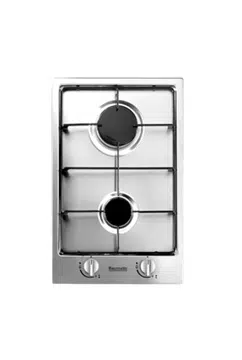Loading ...
Loading ...
Loading ...

IMPO RTANT INSTA L LATION
SPEC IFICATI O NS
The rear wall and the surfaces surrounding
and adjacent to the appliance must be able to
withstand an overtemperature of 65 K. The
adhesive used to stick the plastic laminate to
the cabinet must be able to withstand a
temperature of not less than 150 °C otherwise
the laminate could come unstuck. The
appliance must be installed in compliance with
BS 6172 1990, BS 5440 part. 2 1989 and BS
6891 1988. This appliance is not connected to a
device able to dispose of the combustion
fumes. I t must therefore be connected in
compliance with the above mentioned
installation standards. Particular care should
be paid to the following provisions governing
ventilation and aeration.
5) ROOM VENTILATION
To ensure correct operation of the appliance, it is
important to ensure that the room where the hob
is installed has sufficient ventilation, as set out in
BS 5440 part 2. 1989. See table below.
Natural air flow must enter directly through
permanent openings in the walls of the room in
question. These must open towards the outside and
possess a minimum section of 100 cm
2
see fig. 3). It
must be impossible to obstruct these openings.
Indirect ventilation with air drawn from adjacent
rooms is permitted in strict compliance with the
provisions in force.
6) LOCATION AND AERATION
Gas cooking appliances must always dispose of their
combustion fumes through hoods. These must be
connected to flues, chimneys or straight outside. If it is
not possible to install a hood, an electric fan can be
installed on a window or on a wall facing outside (see
fig. 4). This must be activated at the same time as the
appliance (see fig. 5), so long as the specifications in the
provisions in force are strictly complied with.
7) GAS CONNECTION
A gas hob can only be connected by a GASSAFE
Registered engineer.
Installations should be carried out in accordance with BS
6891 1988 and must comply with the Gas Safety
Regulations.
All hob installations must include an isolation tap.
GAS PRESSURE TEST
Some hob models have a test point fitted under the
control panel, to conduct a gas pressure test proceed as
follows:
- Turn off the gas supply.
- Remove screw in the pressure test point, place
test gauge connecting tube on test point.
- Fit a burner ring and cap onto burner assembly,
replace control knob onto corresponding control
tap for the burner.
- Turn on gas and ascertain working pressure.
After test, turn off control tap, turn off gas supply,
disconnect test gauge connecting tube. Replace the test
point screw, turn gas back on and test for
soundness. Reassemble the hob.
IMPORTANT:
the appliance complies with the provisions of the
following CEE Directives:
- 2009/142 + 93/68 regarding gas safety.
INSTALLATION
7
Before connectiong the appliance, check the
values on the data label affixed to the
underside of the hob correspond to thos of the
gas mains in the home. A label on the
appliance indicates the regulating conditions:
type of gas and working pressure.
WARNING:
Domestic
ovens
hobs or
any
combinations
Loading ...
Loading ...
Loading ...
